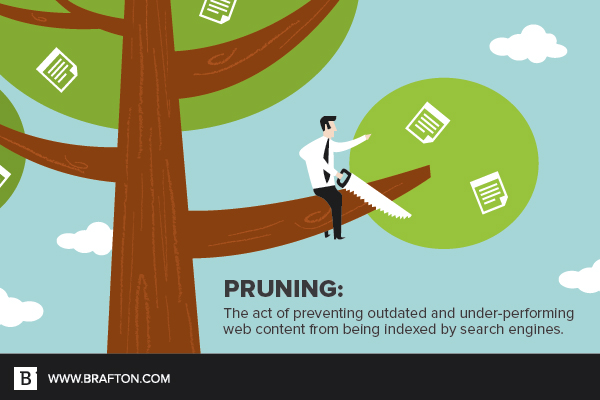Writing is rewriting, as the saying goes. Despite many writers believing their work is perfect as is (guilty!), experts agree a round or two of merciless editing is the best way to enhance prose.
This is a lesson that can be applied to content marketing. However, instead of re-editing content for maximum readability, your goal is to edit your site and ensure existing content supports search engine optimization.
Enter content pruning – the act of removing web pages that are indexed by search engines.
“Why on Earth would I do that?” you ask, a horrified look on your face.
Because, dear reader, content pruning improves your website in the eyes of the almighty search engine.

First, you can delete pages. While this may sound scary, it doesn’t have to mean losing content altogether. You can repurpose deleted content to create new, better optimized pages.
You can also arrange to have pages remain accessible to website visitors but fail to be recorded through deindexing.
The trick is deciding which approach is right for your content marketing strategy.
The power of pruning
Search engines today are laser-focused on content quality. Pages created with simplistic, uninformative content or black hat SEO techniques damage ranking performance.
Additionally, some experts contend search engines award scores based on an average of every page on a website. Since certain web scripts automatically generate indexable URLs, it can make search engines think a website has more pages than it actually does, dragging down scores. Getting rid of these URLs reduces the number of pages being analyzed, making it easier to improve score averages.
However, it’s important not to get carried away once you break out the shears.
“Content pruning can be advantageous for your SEO and overall rankings. However, you want to be careful that you aren’t getting rid of content that has technical value you might not see without conducting an audit,” said Brafton Account Director Sonny Sharp. “Things like deleting a page you might not find relevant anymore but has a very healthy link portfolio can do more harm than good to your website. Just be sure you are conducting thorough technical audits to identify the pages that truly can be pruned, and those that should not due to healthy SEO indicators.”
How to conduct an audit
Your first step should be creating a comprehensive listing of all website URLs. From there, you can examine the performance of these pages, analyzing everything from total amount of views to number and quality of backlinks created.
Next, rank your pages based on these performance metrics. Create a benchmark to differentiate content that is helping SEO from content that is dragging it down.
Finally, decide which pages are heading to the chopping block, as it were.
Before you swing the axe, however, determine if the content should be deleted, deindexed or repurposed with improved SEO techniques.
How often you audit your website for potential pruning depends on its depth. The more content you create and the longer it exists, the easier it will be to determine what is and isn’t working. That said, it’s smart to plan on biannual audits to keep things optimized.
“Be sure you are conducting thorough technical audits to identify the pages that truly can be pruned, and those that should not due to healthy SEO indicators.”
To delete or deindex?
If content serves no purpose for website visitors and is performing poorly, deleting it is the right move. This is especially the case if SEO techniques, such as keyword stuffing, that have gone from wearing white to black hats were used in content creation. This type of content can be actively punished by search engines.
If you have web pages that are performing poorly yet may still be valuable for website visitors, deindexing is your best bet. This is a simple matter of applying a noindex meta tag, as outlined by Google. This way, search engines like Google will not be able to index selected pages, yet they will still be accessible on your website.
Keep in mind that if there are backlinks to content you plan to delete, it’s essential to redirect this traffic to either an equally relevant piece of content or an appropriate internal page. Finding relevant content as a replacement becomes that much easier if you decide to repurpose deleted pages.
Repurposing content
If you’re dead set on deletion, consider how you may be able to repurpose existing content.
Perhaps some content is no longer relevant due to industry changes. Maybe otherwise-quality content was being dragged down due to black hat SEO techniques.
In cases such as these, repurposing content with white hat SEO strategies, including updated keywords and current information, is an effective way to hold on to existing content while increasing its value.
While you should always approach content pruning strategically and with due diligence top of mind, don’t be afraid of deleting or deindexing your content. It’s less getting rid of beloved content and more letting go of dead weight.





